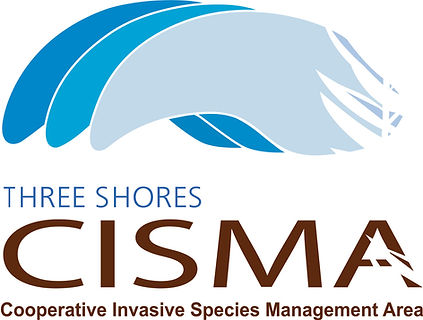While our snow is disappearing (and in many areas mostly gone), it’s time to watch out for
invasive species that are easily visible in spring and early summer. Invasive species, such as garlic
mustard and invasive phragmites, are non-native species that cause harm to our economy,
environment, and/or human health. While many invasive species typically grow throughout summer and
are difficult to recognize, these two species are easy to spot as the snow fades away.
While visible all winter long, invasive phragmites is one of two species that is highly visible in the
spring and early summer and is a focus of our early seasonal work here at the Three Shores CISMA.
Invasive phragmites is an aquatic tall grass-like plant that creates dense monocultures (where it is the
only plant growing in the habitat) and quickly dominates every ecosystem it invades by producing close
to 2,000 seeds per year and spreading through lengthy rhizomes (or horizontal, underground stems
capable of producing new stems). These stems can also easily become dislodged or fragmented,
resulting in the spread of new infestations throughout the area.
Sometimes confused with its relative, native phragmites, invasive phragmites can grow upwards
of 7 to 20 feet tall, while native phragmites rarely grows taller than six to seven feet tall. In early spring,
invasive phragmites’ stalks will appear brown, with fluffy seed heads, stalks with ridges along its stem,
and leaves still attached to its stalk. On the other hand, native phragmites will likely not have leaves
attached to its stem, smoother stems, and a significantly smaller, more string-like seed head. As we
move further into summer, both species will begin to send up new shoots and can sometimes be hard to
distinguish until reaching full growth. One distinction that may help during this time is the coloration of
the stem of the two species. Native phragmites’ stalks will often have multiple bright red segments
growing near the base of the stalk, while the invasive phragmites’ stalks are purely tan or light green.
Similarly, another species we focus on in spring and early summer through the Three Shores
CISMA partnership is garlic mustard. In its first year of growth, garlic mustard forms a rosette of dark
green, heart-shaped leaves close to the ground. In the second year of its life cycle, garlic mustard sends
up a flowering stalk in early summer that produces small white flowers with four petals. The flowers are
arranged in clusters at the end of the stem and typically bloom in June in the Eastern Upper Peninsula.
One of the most distinguishing features of garlic mustard is its distinct garlic odor, which is
noticeable when the leaves are crushed or bruised. Another identifying characteristic is the shape of the
seedpods, which are long and narrow, resembling a curved bean pod. These can produce hundreds of
seeds that are dispersed by wind or animals and quickly dominate forested or shady areas, creating an
inhospitable environment for native plants and wildlife.
While both invasive phragmites and garlic mustard can be found widespread throughout the
Lower Peninsula, their distributions are limited in the Eastern Upper Peninsula and early detection is key
to preventing their spread throughout the region. That’s where we need your help! If you’re out
enjoying the beauty of an Upper Peninsula spring and summer, keep an eye out for these species. If you
notice them, send us an email at threeshorescisma@gmail.com with the location of the infestation you
have found so we can provide a rapid response and help control the spread. Together, we can help
prevent the spread of invasive species throughout our pristine Upper Peninsula!
- Keeping The Piece Quilters Guild to hold annual show in September - July 2, 2023
- District Court Report: April 20, 2023 - April 21, 2023
- Early Invaders of the Eastern Upper Peninsula - April 18, 2023



